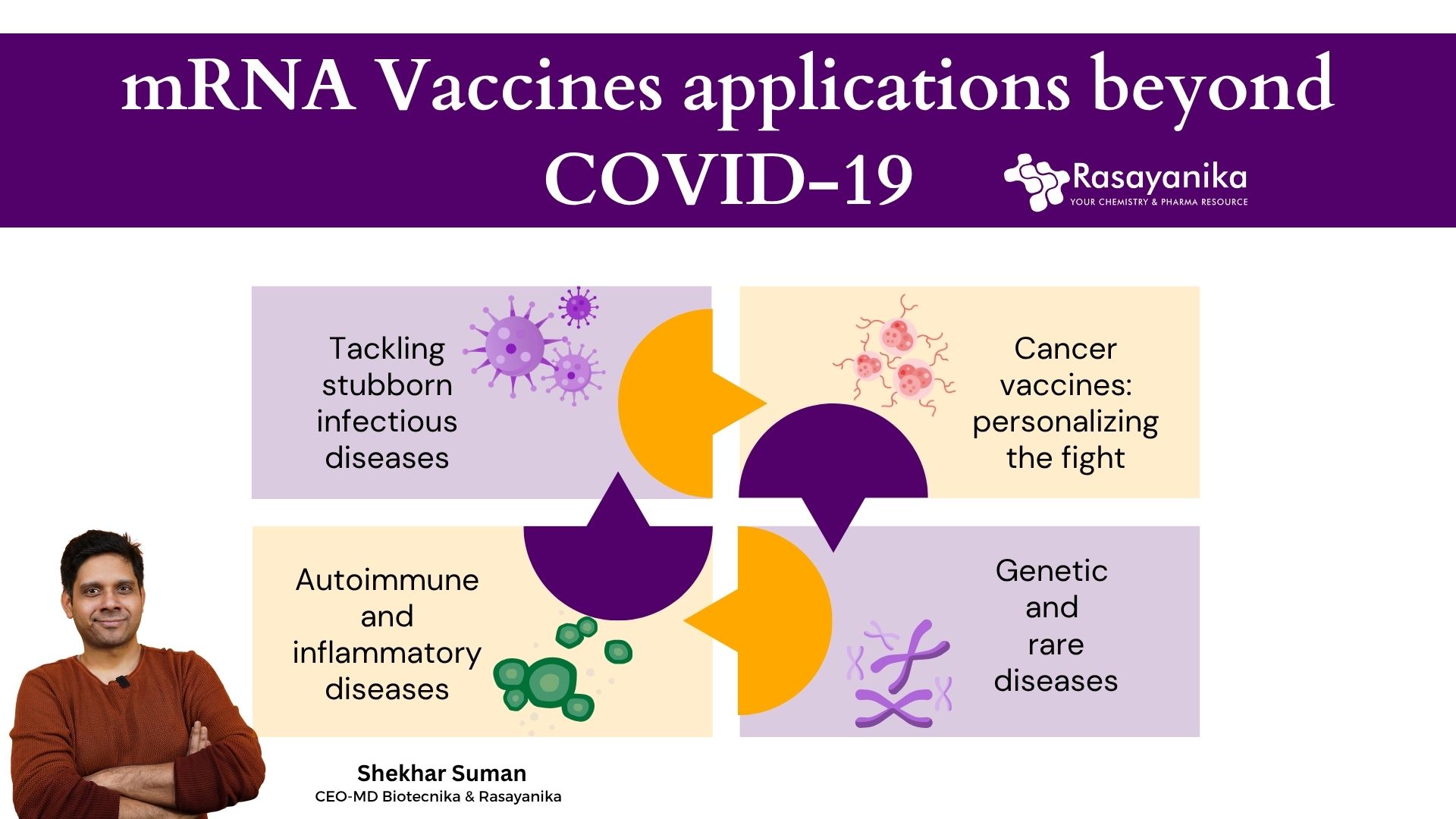mRNA Vaccines Beyond COVID-19: What’s Next?
Who doesn’t remember the lockdown times? For many, it was the scariest period of their lives. Yet, it was also a time when science proved its resilience. With decades of research already underway, the first messenger RNA (mRNA) vaccines were rolled out in 2020, and the world watched in awe.
This was achievable only because of the decades of research that happened under mRNA technology, lipid chemistry, and delivery systems. When the COVID-19 outbreak struck, researchers were able to translate that foundation into a lifesaving solution. The first mRNA product COVID-19 vaccine to receive FDA approval was Pfizer’s.
In the years since, billions of doses have been administered. What began as a bold experiment is now regarded as a powerful approach to disease prevention and treatment. And now the massive question for the scientific community is: what lies ahead? The journey of mRNA Vaccines Beyond COVID-19 is only just beginning.
Why is mRNA technology a game-changer?
Traditional vaccines often rely on weakened pathogens or protein subunits, which take years or even sometimes decades to design and manufacture. In contrast, mRNA vaccines work by delivering a synthetic strand of nucleoside-modified RNA that carries instructions to build harmless fragments of viral proteins. These fragments “teach” the immune system to recognize and fight the real pathogen if encountered.
This adaptability is one of the strongest reasons why researchers continue to explore the promise of mRNA Vaccines Beyond COVID-19, knowing that the same principles can be applied to many diseases.
What makes this revolutionary?
- Time required for designing the Vaccine: Once scientists know the genetic code of a pathogen, they can create an mRNA sequence within weeks.
- Flexibility: The platform is adaptable. A slight tweak to the code can target new variants or entirely different diseases.
- Safety: Because mRNA never enters the nucleus, it does not alter our DNA. It is broken down naturally after delivering its message.
- Scalability: Large-scale production is easier compared to traditional methods, once facilities are set up.
One additional important factor from a chemistry perspective is that the breakthrough also lies in nucleoside modifications, such as pseudouridine, which reduce innate immune detection and enhance stability. Moreover, lipid nanoparticles (LNPs), tiny spheres made of ionizable lipids, cholesterol, and phospholipids. Encapsulate and protect fragile mRNA, acting as a delivery vehicle that fuses with cell membranes. Without these advances in chemistry, the success of mRNA vaccines would not have been possible.
Expanding horizons: applications of mRNA Vaccines Beyond COVID-19
The success of COVID-19 vaccines helped the researchers build more potential and promising vaccines for other types of diseases as well.
- Tackling stubborn infectious diseases
Some pathogens have long defied traditional vaccine approaches due to their complexity or rapid mutation. mRNA vaccines, with their ability to encode multiple antigens simultaneously, could change that.
- Norovirus: This virus is also known as the “winter vomiting bug.” Norovirus is a global burden. Early clinical trials are exploring mRNA vaccines that could provide broad protection against multiple strains.
- RSV (Respiratory Syncytial Virus): A major cause of infant and elderly hospitalizations, RSV vaccines built on mRNA technology are now in advanced stages of testing.
- Universal flu vaccines: Unlike seasonal flu shots, which change annually, if the research succeeds in mRNA formulation, this could target conserved viral proteins. This will not only offer a broader protection for different types of vision but also provide a longer-lasting protection.
If these trials succeed, they could transform how humanity prepares for viral epidemics.
- Cancer vaccines: personalizing the fight
Perhaps the most exciting frontier for mRNA Vaccines Beyond COVID-19 lies in oncology. Personalized cancer vaccines are being designed to train the immune system against each patient’s unique tumour mutations.
- Doctors sequence tumour DNA to identify neoantigens, mutated proteins found only in cancer cells.
- An mRNA vaccine encoding these neoantigens is created.
- Once injected, the vaccine activates T cells to recognize and destroy cancer cells.
Clinical trials are already underway in melanoma, pancreatic cancer, and lung cancer. Results suggest that combining mRNA vaccines with immunotherapies, such as checkpoint inhibitors, could significantly enhance survival rates.
- Genetic and rare diseases
For patients with rare genetic disorders, treatment options are often limited. Here, mRNA functions like a temporary protein replacement system.
- If a faulty gene prevents a crucial protein from forming, synthetic mRNA can provide instructions for cells to make that protein.
- Researchers are also experimenting with mRNA to deliver missing enzymes in metabolic disorders.
Unlike gene therapy, which makes permanent DNA edits, mRNA therapy is transient and reversible, offering a safer option in many cases.
- Autoimmune and inflammatory diseases
Scientists are also testing whether mRNA technology could help retrain the immune system to tolerate, rather than attack, the body’s own tissues. Diseases like multiple sclerosis and type 1 diabetes may one day be managed using mRNA-based therapies that reduce autoimmune reactions. While still experimental, this approach could revolutionize how we treat chronic immune conditions.
Challenges on the road ahead
Despite the optimism, adopting this technology requires solving key challenges such as;
- Stability and storage: Early COVID-19 vaccines required storage at –70°C. Advances in chemical stabilizers and freeze-drying techniques may soon allow storage at standard refrigerator temperatures.
- Efficient delivery: Ensuring mRNA reaches the right cells without triggering excessive inflammation is an ongoing challenge. Chemistry-driven innovations in lipid design and biodegradable polymers are helping.
- Safety and durability: Current data show mRNA vaccines are safe, but long-term effects of repeated boosters need continued monitoring.
- Access and equity: Manufacturing costs, patents, and distribution logistics will determine whether this technology reaches developing countries.
What’s next in the near future?
Looking forward, here are some milestones that could soon become reality:
- Approval of the first mRNA vaccine for RSV, likely within the next few years.
- Expansion of personalized cancer vaccine trials across diverse tumour types.
- Development of more chemically stable formulations to ease global distribution.
- Rapid “plug-and-play” vaccine design for emerging outbreaks, ensuring better pandemic preparedness.
Why this matters for healthcare
- Pandemic preparedness: as the technology helps in faster production of vaccines, one can consider having a turnaround for new pathogens.
- Global health equity: If costs and stability issues are addressed, even remote regions could benefit from cutting-edge vaccines.
The COVID-19 pandemic may have fast-tracked this innovation, but its potential goes far beyond.
Advances in molecular science enabled the world’s first mRNA vaccines, and they will continue to drive the next breakthroughs.
Out of the tragedy of COVID-19 emerged a scientific silver lining—a flexible, scalable, and safe vaccine platform. From preventing flu and RSV to tackling cancers and rare genetic diseases, the possibilities are enormous. Challenges remain, but history shows that when global collaboration, funding, and science converge, progress accelerates.
The next chapter of vaccine innovation is being written right now. And one day soon, you may roll up your sleeve not just for protection against infection, but for a personalized therapy designed t















































